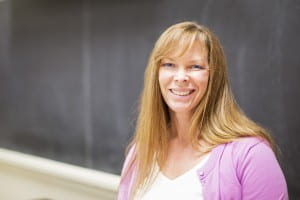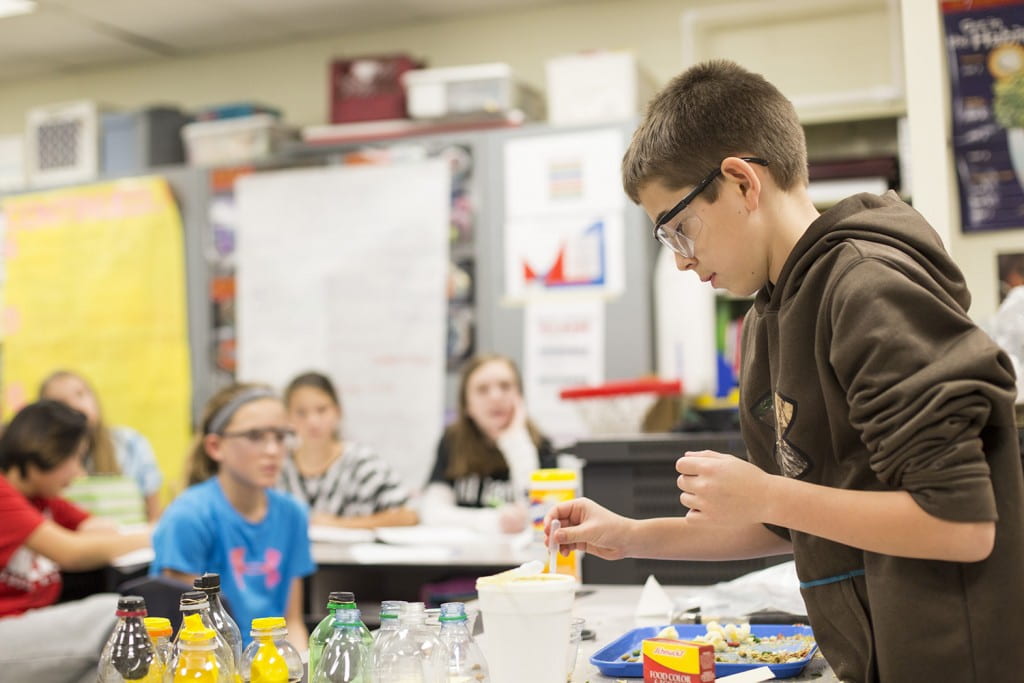Debbie Spiezio has taught in Rockwood School District for nearly 30 years, and today, her students will learn about the digestive system. However, the curriculum that will guide this lesson was not something that she found online, that her district provided her, or that was written by someone at an education corporation on the other side of the country. Instead, a fellow educator in a neighboring district wrote this lesson.
In July 2015, Spiezio, along with 40 other educators in the St. Louis area, gathered at Washington University’s MySci Resource Center to create a new type of science curriculum for middle school students.
The project, MySci 6-8, fills a need that has received increased attention on the national stage, the need for students interested and capable in the areas of science, technology, engineering, and math (STEM). With the support of the Monsanto Fund, MySci 6-8 set out to create hands-on modules that would engage middle school students in STEM, by tapping into the collective knowledge of one of the most important stakeholders.
“It was an honor to be asked our opinion,†said Gina Pereda, a fellow MySci collaborator with Spiezio and a teacher in the Ferguson Florissant School District. “I think that every teacher should have the ability or the opportunity to share what they know. There are a lot of great ideas out there, and getting together in a specific spot to do that sharing I think is valuable.â€

Pereda and Spiezio, along with two other educators, spent a week in July at the MySci Resource Center writing one module centered on human impacts on the environment. With over 50 years of combined teaching experience, the pair brainstormed new and creative ways to engage students around the topic.
“It was neat to get to collaborate with teachers from different districts,†Spiezio said. “And it was fun to hear the ideas that you have in your head get bounced off of someone else that is just as excited about the same topic, as nerdy as it may be.â€
This approach of collaboration and teacher-inspired design is not new to MySci. In fact, the program used the same approach to develop 24 units for the elementary level three years ago.
“The importance of teacher leadership is really one of our core beliefs,†said Rachel Ruggirello, the assistant director of the Institute for School Partnership that runs the MySci program. “We believe curriculum that is inspired and written by teachers will more effectively meet their needs and will ultimately result in better students outcomes.â€
In addition to writing the lessons, each of the 40 teacher writers had the opportunity to pilot test one or more of the middle school modules in their own classroom. For Spiezio that meant piloting a lesson on the human body written in part by a teacher in her own district.
During one lesson, her students gathered at the back of the classroom, eagerly watching as Spiezio and several student volunteers walked the class through a hands-on model of the human digestive system.
“I could have taught the digestive system today and told the kids to read a section out of that textbook sitting on their table,†Spiezio said. “They would have gotten the same information, but I bet 12 of my 30 students wouldn’t have understood it.â€
In Pereda’s eighth grade earth science classes, she experiences similar challenges. Often what works for one group of students, such as reading an informational article or textbook, isn’t effective for another group.
Since piloting the MySci module, Pereda said that the interest level in her class has increased and that the information in the kits is sticking with her students.
“Every kid made gains in their work as far as from the pre to the post (assessment),†Pereda said. “It has proved to me that the kits are a good idea, that the modules are a good idea.â€
Moving forward, Pereda and Spiezio will both have the opportunity to pilot more of the hands-on MySci kits, and the comments from these two and other teacher writers will help make the modules better for future use.
“I enjoyed (MySci), and I hope that I have the pleasure of coming back and doing more of it in the future,†Spiezio said. “It’s the way science should be taught, and it’s the way science teachers should be thinking about science.â€
January 2016 | by, Gennafer Barajas
